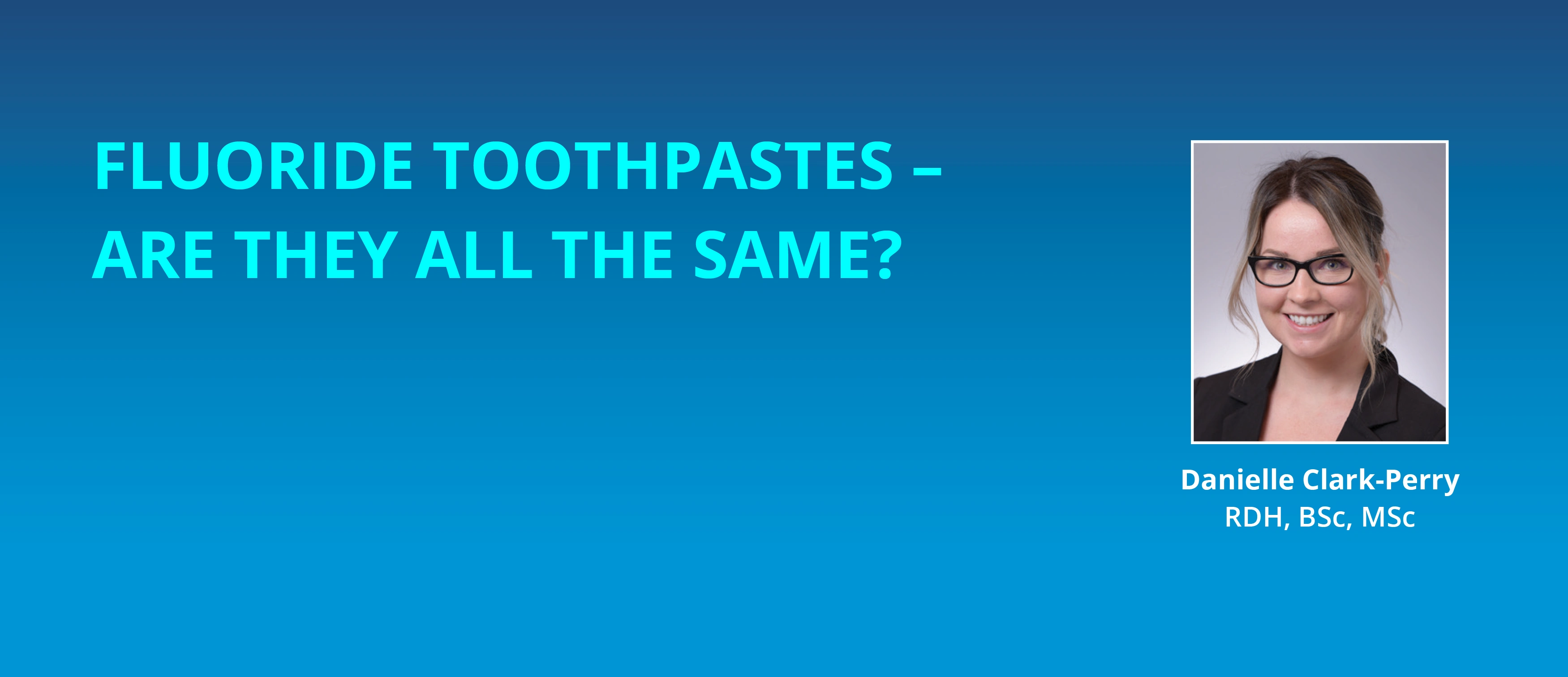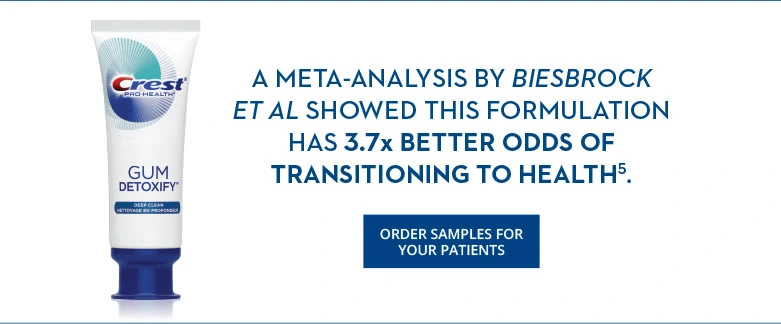Fluoride Toothpastes – Are They All The Same?
Prevention is arguably the most important aspect of the dental profession. Preventing dental disease for our patients is part of our ethical obligation as health care providers and should always remain the top priority during each and every appointment. Bacteria are the culprit of not one, but the two main dental diseases: caries and periodontal disease.1 Therefore, most of our efforts should be dedicated to working with the patient on how to remove the bacteria and implement measures to prevent dental disease and maintain the dentition.
Mechanical removal of the biofilm with toothbrushes and interproximal cleaning aids is paramount in the prevention of caries and periodontal disease.2 Taking the time to sit with patients, a mirror and oral hygiene aids and show them how to mechanically remove biofilm in all areas of the mouth is one step. Following up and measuring progress with disclosing solution is another way to educate and encourage good oral hygiene. Another way to facilitate good oral hygiene and prevent disease is having a conversation about toothpaste. The toothpaste a patient is using should also be a part of their oral hygiene treatment plan. For example, if a patient has a high caries risk, higher fluoridated toothpaste and fluoride varnish treatments are effective and might be recommended. But what about the other “regular” fluoridated toothpastes? Is there a difference amongst the fluoridated toothpastes on the market?
Different fluoride formulations in toothpastes exist such as sodium fluoride, sodium monofluorophosphate, amine fluoride and stannous fluoride. Although they all contain the important ingredient fluoride, the bioavailability of the fluoride (ability to have an effect) is influenced by its formulation. Thus, it is not only the amount of fluoride that is a consideration, but the fluoride carrier as well. Stannous, for example, is the carrier in stannous fluoride toothpastes and the antibacterial properties of stannous seem to provide favourable clinical results.3 Stannous fluoride has three mechanisms of action. The first is its bacteriacidal and bacteriostatic properties.4 Stannous is able to inhibit and reduce plaque formation as it is shown to suppress the growth and reproduction of bacteria leading to clinical reductions in plaque quantity and consequently, gingivitis reduction.5 Its second mechanism of action is its ability to inhibit plaque metabolism, meaning, it can inhibit the acid production of the bacteria responsible for dental caries.6 Finally, its third mechanism of action is its suppression of pathogen virulence.7,8 Because stannous can bind to LPS and LTA on pathogenic bacteria and consequently suppress the LPS and LTA interaction with Toll like receptors, the immune response is decreased and so is the inflammation.7,8
With these three mechanisms of action, the combination of stannous with fluoride has benefits beyond just anti caries and sensitivity relief. It is also noteworthy that not all stannous formulations are the same, however, gluconate chelated stannous fluoride toothpastes have been shown to provide reductions in gingivitis.5 A 2019 meta analysis showed patients had 3.7 times better odds transitioning from localized or generalized gingivitis to generally healthy when using a stannous fluoride toothpaste and that the use of stannous toothpaste contributed to a 51% reduction in bleeding sites when compared to a sodium fluoride or sodium monofluorophosphate toothpaste.5 Therefore, when we sit with patients at each appointment reviewing and improving the preventative aspect of their treatment plan, discussing toothpaste is important. When recommending a fluoride toothpaste, considering stannous fluoride formulations with anti microbial efficacy and gingival health benefits that extend beyond the anti caries benefits, should be considered. When it comes to fluoride toothpastes, it actually isn’t the same thing in different tubes and it is important to communicate this to our patients. Most of all, it is important that we remember that prevention is key.9 Dedicating time at the beginning of the appointment to discuss the preventative aspect of the patient’s treatment plan, disclose, and provide hands on demonstration of techniques is invaluable to the oral health of patients.
In a meta-analysis that we conducted, we analyzed randomized controlled clinical trials comparing stannous fluoride toothpaste formulations with other fluoridated toothpastes not containing stannous fluoride10. 16 studies were included and at a North American scientific review panel workshop, the following conclusion statement was derived - “Recent developments in the formulation of a stabilized stannous fluoride toothpaste, show better clinical results in randomized controlled trials when compared to other types of fluoridated toothpastes for reduction of gingival inflammation and plaque removal. This may help in prevention of caries and periodontal diseases.”
References:
1. Kwon T, Salem DM, Levin L. Nonsurgical periodontal therapy based on the principles of cause-related therapy: rationale and case series. Quintessence Int. 2019;50(5):370-376.
2. Kwon T, Lamster IB, Levin L. Current concepts in the management of periodontitis. Int Dent J. 2020 Dec 5.
3. Clark-Perry D, Levin L. Comparison of new formulas of stannous fluoride toothpastes with other commercially available fluoridated toothpastes: A systematic review and meta-analysis of randomised controlled trials. Int Dent J. 2020 Dec;70(6):418-426.
4. Ramji N, Baig A, He T, Lawless MA, Saletta L, Syszcynsky-Meister E, Cog-gan J. Sustained antibacterial actions of a new stabilized stannous fluoridedentifrice containing sodium hexametaphosphate. Compend Contin EducDent 2005;26(Suppl 1):19-28.
5. Biesbrock A, He T, DiGennaro J, Zou Y, Ramsey D, Garcia-Godoy F. The effects of bioavailable gluconate chelated stannous fluoride dentifrice on gingival bleeding: Meta-analysis of eighteen randomized controlled trials. J Clin Periodontol. 2019 Dec;46(12):1205-1216.
6. Cannon M, Khambe D, Klukowska M, Ramsey DL, Miner M, Huggins T, White DJ. Clinical Effects of Stabilized Stannous Fluoride Dentifrice in Reducing Plaque Microbial Virulence II: Metabonomic Changes. J Clin Dent. 2018 Mar;29(1):1-12.
7. Haught C, Xie S, Circello B, Tansky CS, Khambe D, Klukowska M, Huggins T, White DJ. Lipopolysaccharide and Lipoteichoic Acid Virulence Deactivation by Stannous Fluoride. J Clin Dent. 2016 Sep;27(3):84-89.
8. Klukowska M, Haught JC, Xie S, Circello B, Tansky CS, Khambe D, Huggins T, White DJ. Clinical Effects of Stabilized Stannous Fluoride Dentifrice in Reducing Plaque Microbial Virulence I: Microbiological and Receptor Cell Findings. J Clin Dent. 2017 Jun;28(2):16-26.
9. Levin L. Prevention--the (sometimes-forgotten) key to success. Quintessence Int. 2012 Oct;43(9):789. PMID: 23041993
10. Clark-Perry D, Levin L. Comparison of new formulas of stannous fluoride toothpastes with other commercially available fluoridated toothpastes: A systematic review and meta-analysis of randomised controlled trials. Int Dent J. 2020 Dec;70(6):418-426. doi: 10.1111/idj.12588. Epub 2020 Jul 4. PMID: 32621315.








